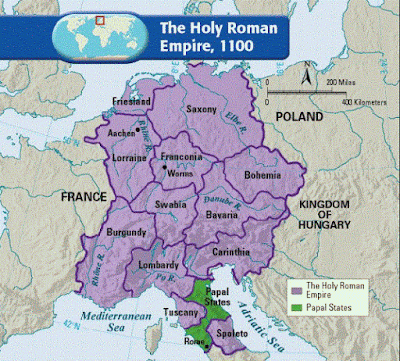The Normans of Italy
Not long before the
crusade began, much of Italy was still considered part of the (Eastern) "Roman Empire" and
its leaders swore fealty to the Emperor in Constantinople. Rome itself was nominally independent but
heavily influenced by the German empire, AKA: “ZE HOLY ROMAN EMPIRE!” Here’s a map to clarify:
As mentioned in previous posts,
by 1096 Byzantium had lost most of its power to invading Muslim, and
Viking/Norman forces. One of the most
infamous names in Alexius’s court was Bohemund.
Named after a mythical giant, he was the recently disinfranchised son of
Robert Guiscard, a powerful Duke in Norman Italy. Guiscard is known primarily for attempting and
failing to conquer the Byzantine Empire.
As you might have guessed, Bohemund was likley the most motivated
champions of The Crusade. His role in
the Crusade is the epidime of the saying: “The
enemy of my enemy, is my friend.” Alexius
thought he could control one simple barbarian but discovered that he had in
fact , made a deal with the devil.
Bohemund (A name and a
title in and of itself): Scourge of
Empires
Bohemund I, byname Bohemond of Otranto,
French Bohémond de Tarente, original name Marc
(born 1050–58—died March 5 or 7, 1109, probably Bari [Italy]), prince of
Otranto (1089–1111) and prince of Antioch (1098–1101, 1103–04), one of the
leaders of the First Crusade, who conquered Antioch (June 3, 1098).-Encyclopedia Britanica
His exploits are almost too
fantastic to believe. He inherited his father’s lust for Byzantine land and
devoted his life to conquering the wealthiest, and most powerful kingdom in the
world. He tasted both victory and defeat
but always with a heaping side of glory!
Fighting the Eastern Roman Empire, he learned ancient Roman tactics and
discipline, along with modern eastern tactics, as well as multiple
languages.
Always outnumbered, he developed a
shrewd mind for diplomacy and intelligence gathering. By the time of the crusades, his small
retinue had been forged into an elite, versatile, fighting machine. His leadership and courage were famous on
both sides of the conflict. He emerging
victorious in countless pitched battles, some of which his men were outnumbered
100-1. He led the only special
operations unit in the Crusader Army, which gave medieval poets their very own “Trojan
epic” in the siege at Antioch.
By the end of the Crusade Bohemund
was a legend. He was both feared and
respected by his enemies, well… except for Raymond of course, he was always
muddling up poor old Sir Raymond’s plans.
Though I wouldn’t put him in the “good guy”
category, his shrewd (or diabolical) political and military genius, combined
with just the right balance of arrogance and humor make him one of my favorite
figures in medieval history.
History records him as a handsome
man, a warrior of genius, and a gifted diplomat. He was all these things, as
well as treacherous, duplicitous, and ambitious.[1]
Tancred, Greek’s Bane, Slayer of Saracens
Tancred of Hauteville, French
Tancrède de Hauteville (born c.
1075—died December 12, 1112, Antioch [now in Turkey]), regent of Antioch,
one of the leaders of the First Crusade.-Encyclopedia Britanica.
Tancred
was a Norman lord of south Italy. He went on the Crusade with his uncle,
Bohemond (the future Bohemond I of Antioch), and first distinguished himself as
brave, honorable, selfless (by comparison to his peers) and fiercely loyal to
both his uncle and the crusader cause.
When
he wasn’t praying, or rescuing women and children from Godfrey and Raymond’s
hordes of mad raiders, also known as “crusader pilgrims” (civilian levies, and
mercenaries). He was fighting Muslim warriors with one hand and Romans (Byzantines) with the other!
He shared his family’s disdain for Byzantium,
and was the only knight who staunchly
refused to swear fealty to Alexius (A sort of non-compete clause), in exchange
for logistical aid for the crusader enterprise.
He was ocaisionally attacked by the emperor’s forces, attempting to
assassinate him while on the march, but sent them all crying home to
momma.
The
attack/assassination attempt vindicated Tancred’s mistrust of the emperor, and
supplied him with ample zeal for his uncle’s cause, and secret plans for
Antioch >.>
He
first gained notoriety for himself in Cilicia, where he captured Tarsus from
the Turks and came into conflict with his fellow Crusader, Baldwin of Boulogne.
He played a prominent part in most of the major battles of the Crusade, and
after the capture of Jerusalem (1099) he received the title Prince of Galilee.
He served as regent of the principality of Antioch for Bohemond while the
latter was a prisoner of the Danishmends (1101–03)
Tancred
never attempted to usurp his uncle’s rule and was rewarded for his fidelity
with permanent control of Antioch after Bohemond returned to Europe in 1104.
As
regent of Antioch, and also of Edessa from 1104 to 1108, Tancred became the
chief Latin magnate of northern Syria, engaging in continual warfare with both
the Turks, Raymond, and the Byzantines until his death. Like so many of his peers, he died
young. Though no sword could touch him,
a Typhoid epidemic swept Antioch and he was among the many casualties.
That
was the “official” report anyway, I like to think he left public life to serve
as a lonely Templar (The creation of the order is attributed to Godfrey). Traveling the land slaying bad guys and
rescuing damsels in distress until he finally met his end, shortly after Indiana Jones took his cup.
[1]
Hugh Hill, John & Hill L., Laurita -authors. “Bohemond I| Biography – Prince
of Antioch." Encyclopedia Britannica Online. Encyclopedia Britannica. Web.
2 Sept. 2015.











No comments:
Post a Comment